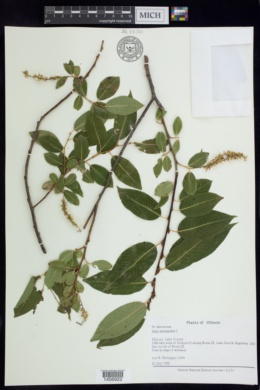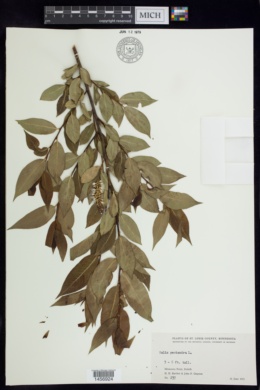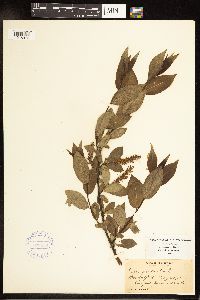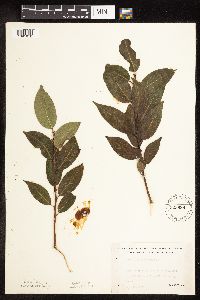Salix pentandra
|
|
|
|
Family: Salicaceae
Bay-Leaf Willow
|
Shrubs or trees, 5-15 m. Stems: branches flexible at base, brownish or yellow-green, highly glossy, glabrous; branchlets yellow-green, red-brown, or brownish, glossy, glabrous. Leaves: stipules absent or rudimentary on early ones, rudimentary or foliaceous on late ones, apex rounded; petiole deeply to shallowly grooved adaxially, 5-15 mm, with pairs or clusters of spherical glands distally or throughout, glabrous adaxially; largest medial blade hypostomatous, narrowly elliptic, elliptic, or lanceolate, 50-135 × 20-50 mm, 2-4 times as long as wide, base convex, margins slightly revolute or flat, serrulate, apex acuminate, abaxial surface pale not glaucous, glabrous, adaxial highly glossy, glabrous; proximal blade margins entire or serrulate; juvenile blade reddish, glabrous abaxially. Catkins: staminate 27-81 × 9-13 mm, flowering branchlet 9-21 mm; pistillate moderately to densely flowered, slender or stout, 29-68 × 7-15 mm, flowering branchlet 9-42 mm; floral bract 2-4 mm, apex acute or rounded to truncate, entire or toothed, abaxially sparsely hairy (mainly proximally), hairs wavy or straight. Staminate flowers: abaxial nectary 0.6-1.7 mm, adaxial nectary square, ovate, or oblong, 0.5-1.5 mm, nectaries distinct or ± connate and cup-shaped; stamens 4-10; filaments distinct, hairy on proximal 1/2; anthers ellipsoid or globose, 0.5-0.6 mm. Pistillate flowers: (abaxial nectary present or absent), adaxial nectary oblong, square, or ovate, 0.4-0.8 mm, (nectaries distinct or connate and shallowly cup-shaped), shorter than or equal to stipe; stipe 0.5-1.6 mm; ovary pyriform, beak bulged below or tapering to styles; ovules 18-22 per ovary; styles connate or distinct, 0.4-0.6 mm; stigmas flat, abaxially non-papillate with rounded tip, or slenderly cylindrical, 0.4-0.6 mm. Capsules 6-9 mm. 2n = 76. Flowering late May-mid Jun. Shores of streams and lakes, marshes, roadsides, waste places; 0-2300 m; introduced; Alta., B.C., Man., N.B., Nfld. and Labr. (Nfld.), N.S., Ont., Que., Sask.; Alaska, Colo., Conn., D.C., Ill., Iowa, Ky., Maine, Md., Mass., Minn., Mont., Nebr., N.H., N.J., N.Y., N.C., Ohio, Pa., R.I., S.Dak., Vt., Va., Wis., Wyo.; Eurasia. The Ohio occurrence is based on information from T. Cooperrider (pers. comm.). Only pistillate plants of Salix pentandra are known to occur in the flora area.
Tree 9 - 11 m tall Leaves: alternate, on 6.5 mm - 1.25 cm long, glandular leafstalks, shiny dark green above, paler beneath, yellow on midrib, 4 - 12.5 cm long, 2 - 5 cm wide, elliptical to egg-shaped to lance-shaped with a rounded or slightly heart-shaped base and short-pointed tip, finely gland-toothed, thick, and aromatic when bruised. Flowers: either male or female, borne on separate trees (dioecious) in cylindrical catkins. The catkin is hairy and grows on a short, leafy stalk. Female catkin 3 - 6 cm long. Ovary hairless. Male catkin 3 - 5 cm long with yellow scales. Stamens five to twelve, with yellow anthers. Fruit: a capsule, in elongated clusters, short-stalked, greenish to light brown, to 10 mm long, and flask-shaped. Seeds have long, white, silky hairs attached. Bark: gray and lightly fissured. Twigs: greenish brown and shiny. Young growth sticky. Buds: yellow to glossy brown, small, egg-shaped, and pointed. Form: compact and oval. Similar species: In the Chicago Region, Salix pentandra differs from most other willows by having finely toothed leaves that are green, hairless, and not revolute (rolled downward along the margins). Salix eriocephala differs by its lance-shaped leaves, while S. lucida bears shiny leaves that are typically less wide than S. pentandra. Salix nigra, which is also similar, differs by having narrowly lance-shaped leaves. Flowering: May, with the leaves Habitat and ecology: Introduced from Europe. Along rivers, streams, lakes, and other wet sites, probably as an escape from cultivation. Occurence in the Chicago region: non-native Etymology: Salix is the Latin word for willow. Pentandra means "with five stamens." Author: The Morton Arboretum Much like no. 5 [Salix serissima (L. H. Bailey) Fernald], but the scales hairy only at the base outside, glabrous or nearly so distally; shrub or small tree to 7 m; staminate catkins mostly 3-6+ cm, the pistillate 3.5-7 cm; stamens 4-9, mostly 5; fr 5-8 mm, on pedicels 0.5-1.5 mm; 2n=76. Native of Europe, cult. and occasionally escaped mainly in the n. part of our range; May-June, the fr maturing in mid- and late summer. Gleason, Henry A. & Cronquist, Arthur J. 1991. Manual of vascular plants of northeastern United States and adjacent Canada. lxxv + 910 pp. ©The New York Botanical Garden. All rights reserved. Used by permission. |





























































































